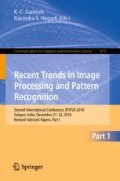Abstract
Identification of language from voice signals is known as automatic language identification. It is very important for speech recognition in multi lingual countries like India where people use more than a single language while talking. Language identification for South Indian languages is difficult for a person without prior knowledge. In this paper, the top 3 most spoken languages of South India namely Telugu, Tamil and Kannada has been distinguished with the help of line spectral frequency based features namely LSF-A (Line spectral frequency-Approximation). Experiments have been performed on multiple datasets having as many as 21700 clips and a highest accuracy of 99.70% has been obtained with a lazy learning-based classifier.
Access this chapter
Tax calculation will be finalised at checkout
Purchases are for personal use only
References
Manjunath, T.N., Hegadi, R.S., Ravikumar, G.K.: A survey on multimedia data mining and its relevance today. IJCSNS 10(11), 165–170 (2010)
Manwani, N., Mitra, S.K., Joshi, M.V.: Spoken language identification for indian languages using split and merge EM algorithm. In: Ghosh, A., De, R.K., Pal, S.K. (eds.) PReMI 2007. LNCS, vol. 4815, pp. 463–468. Springer, Heidelberg (2007)
Gonzalez-Dominguez, J., Eustis, D., Lopez-Moreno, I., Senior, A., Beaufays, F., Moreno, P.J.: A real-time end-to-end multilingual speech recognition architecture. IEEE J. Sel. Top. Sig. Process. 9(4), 749–759 (2015)
Jin, M., et al.: LID-senones and their statistics for language identification. IEEE/ACM Trans. Audio Speech Lang. Process. (TASLP) 26(1), 171–183 (2018)
Aarti, B., Kopparapu, S.K.: Spoken Indian language classification using artificial neural network–an experimental study. In: 2017 4th International Conference on Signal Processing and Integrated Networks (SPIN), pp. 424–430. IEEE (2017)
Bekker, A.J., Opher, I., Lapidot, I., Goldberger, J.: Intra-cluster training strategy for deep learning with applications to language identification. In: 2016 IEEE 26th International Workshop on Machine Learning for Signal Processing (MLSP), pp. 1–6. IEEE (2016)
Revathi, A., Jeyalakshmi, C., Muruganantham, T.: Perceptual features based rapid and robust language identification system for various indian classical languages. In: Hemanth, D.J., Smys, S. (eds.) Computational Vision and Bio Inspired Computing. LNCVB, vol. 28, pp. 291–305. Springer, Cham (2018). https://doi.org/10.1007/978-3-319-71767-8_25
Lopez-Moreno, I., Gonzalez-Dominguez, J., Plchot, O., Martinez, D., Gonzalez-Rodriguez, J., Moreno, P.: Automatic language identification using deep neural networks. In: 2014 IEEE International Conference on Acoustics, Speech and Signal Processing (ICASSP), pp. 5337–5341. IEEE (2014)
Lewis, M.P., Simons, G.F., Fennig, C.D.: Ethnologue: Languages of the world, vol. 16. SIL International, Dallas (2009)
https://www.youtube.com/. Accessed 10 May 2018
Mukherjee, H., Phadikar, S., Roy, K.: An ensemble learning-based Bangla phoneme recognition system using LPCC-2 features. In: Bhateja, V., Coello Coello, C., Satapathy, S., Pattnaik, P. (eds.) Intelligent Engineering Informatics. AISC, vol. 695, pp. 61–69. Springer, Singapore (2018). https://doi.org/10.1007/978-981-10-7566-7_7
Itakura, F.: Line spectrum representation of linear predictor coefficients of speech signals. J. Acoust. Soc. Am. 57(S1), S35–S35 (1975)
Webb, G.I.: Lazy Learning, pp. 571–572. Springer, Heidelberg (2010). https://doi.org/10.1007/978-0-387-30164-8_443
Cleary, J.G., Trigg, L.E.: K*: an instance-based learner using an entropic distance measure. In: Machine Learning Proceedings 1995, pp. 108–114 (1995)
Obaidullah, S.M., Halder, C., Santosh, K.C., Das, N., Roy, K.: PHDIndic\(\_\)11: page-level handwritten document image dataset of 11 official Indic scripts for script identification. Multimedia Tools Appl. 77(2), 1643–1678 (2018)
Obaidullah, S.M., Santosh, K.C., Halder, C., Das, N., Roy, K.: Automatic Indic script identification from handwritten documents: page, block, line and word-level approach. Int. J. Mach. Learn. Cybern. 10, 1–20 (2017)
Hall, M., Frank, E., Holmes, G., Pfahringer, B., Reutemann, P., Witten, I.H.: The WEKA data mining software: an update. ACM SIGKDD Explor. Newsl. 11(1), 10–18 (2009)
Dems̆ar, J.: Statistical comparisons of classifiers over multiple data sets. J. Mach. Learn. Res. 7, 1–30 (2006)
Bouguelia, M.R., Nowaczyk, S., Santosh, K.C., Verikas, A.: Agreeing to disagree: active learning with noisy labels without crowdsourcing. Int. J. Mach. Learn. Cybern. 9, 1–13 (2017)
Vajda, S., Santosh, K.C.: A fast k-nearest neighbor classifier using unsupervised clustering. In: RTIP2R-2016, pp. 185–193 (2016)
Kulkarni, S.B., Kulkarni, R.B., Kulkarni, U.P., Hegadi, R.S.: GLCM-based multiclass iris recognition using FKNN and KNN. Int. J. Image Graph. 14(03), 1450010 (2014)
Mukherjee, H., Obaidullah, S.M., Santosh, K.C., Phadikar, S., Roy, K.: Line spectral frequency-based features and extreme learning machine for voice activity detection from audio signal. Int. J. Speech Technol. 21, 1–8 (2018)
Author information
Authors and Affiliations
Corresponding authors
Editor information
Editors and Affiliations
Rights and permissions
Copyright information
© 2019 Springer Nature Singapore Pte Ltd.
About this paper
Cite this paper
Mukherjee, H., Dutta, M., Obaidullah, S.M., Santosh, K.C., Phadikar, S., Roy, K. (2019). Lazy Learning Based Segregation of Top-3 South Indian Languages with LSF-A Feature. In: Santosh, K., Hegadi, R. (eds) Recent Trends in Image Processing and Pattern Recognition. RTIP2R 2018. Communications in Computer and Information Science, vol 1035. Springer, Singapore. https://doi.org/10.1007/978-981-13-9181-1_40
Download citation
DOI: https://doi.org/10.1007/978-981-13-9181-1_40
Published:
Publisher Name: Springer, Singapore
Print ISBN: 978-981-13-9180-4
Online ISBN: 978-981-13-9181-1
eBook Packages: Computer ScienceComputer Science (R0)

